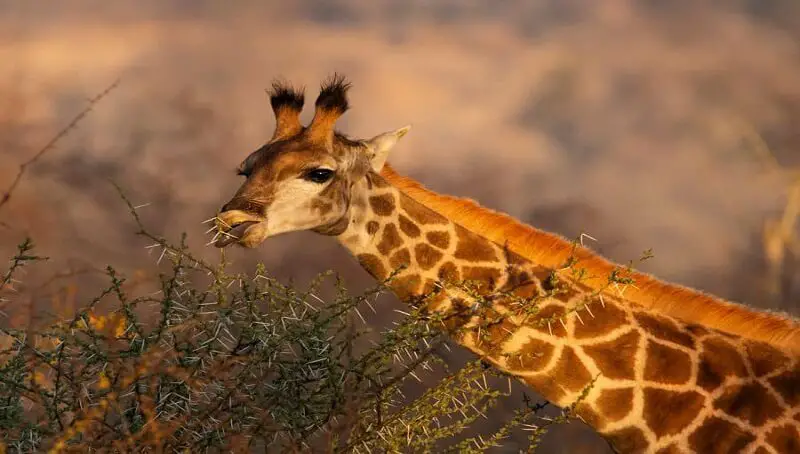
Dog Facts for Kids
November 7, 2022
Incredible Starfish Facts
November 8, 2022
The giraffe, Giraffa camelopardalis meaning “fast walking camel leopard”, is a ungulated mammal with uniform African fingers, the tallest of all species of animals living on land. The giraffe is linked to deer and cattle; however, it is placed in a separate family, Giraffidae, consisting only of the giraffe and its closest relative, okapi.
Giraffes are herbivores, so, this means they only eat plants. Their long necks allow them to reach the leaves, seeds, fruits, buds, and branches up into mimosa and acacia trees. They are known to eat hundreds of pounds of leaves a week. The favorite food of the giraffe is Acacia, a species of tree that grows in the savanna.
Giraffes live in habitats where available food varies throughout the year. During the dry season, giraffes eat evergreen leaves, however, once the rainy season begins, they switch to new leaves and stems that spring up on deciduous trees. Also, the branches and twigs are pulled into the mouth of the giraffe with their long and dextra tongue. In the wild, giraffes can eat up to 66 pounds of food daily, but when it’s dry, they can survive on 7 pounds of food a day.
Giraffes spend up to half of their time feeding, and most of the rest of their time is taken up either by searching for food or by slowly digesting what they have eaten.
When they have the possibility, male and female giraffes feed in different ways. Males focus on the leaves on the highest branches, while females bend their necks to eat closer to the ground. Due to this characteristic behavior, a giraffe can be identified as male or female from a long distance simply by its position while eating. Male giraffes are also more inclined to wander in dense forests, a habitat that females generally avoid.
To drink water or eat grass, the giraffe must bend over and sit in a vulnerable position.
Giraffe’s adaptations
Giraffes have amazing adaptations that help them with their lifestyle in the wild. Because giraffes grow to a very big height, this gives them access to a level of foliage within the reach of all other large animals, with the possible exception of the elephant.
You might also like my articles on what frogs and tarantulas eat and on whether lions eat hyenas.
Giraffes drink large amounts of water and therefore can spend long periods of time in dry and arid areas. When looking for more food, they will venture into areas with denser foliage. The giraffe has hard lips to ensure there is no damage to the mouth when chewing trees and twigs like thorns.
What do giraffes eat while in captivity?
 Giraffes are fed a variety of leaves and twigs but also fruits and vegetables while in captivity. Each zoo offers a slightly different menu for these tall mammals. Among the usual elements offered to giraffes are salad, carrots, apples, bananas, and alfalfa hay. Many zoos lift these foods into the air to simulate the natural behavior of the giraffe’s feeding.
Giraffes are fed a variety of leaves and twigs but also fruits and vegetables while in captivity. Each zoo offers a slightly different menu for these tall mammals. Among the usual elements offered to giraffes are salad, carrots, apples, bananas, and alfalfa hay. Many zoos lift these foods into the air to simulate the natural behavior of the giraffe’s feeding.
In addition to fruits and vegetables, zookeepers often offer their giraffes leafy branches to eat. Some of the common trees used for this purpose include Almond, Myrrh, Mulberry, elm, and poplar. When they eat this type of food, giraffes grab a small branch with their tongues and use their upper lips to break them. This is because giraffes do not have upper teeth.
In the wild, giraffes use mainly their tongues. Many zoos try to encourage similar behavior in captivity, so they put food in small cages. So, if the giraffe wants to eat the food inside the cage, it needs to use its tongue to extract it.
Do giraffes have any natural predators?
Adult giraffes are too large for most carnivores, but younger specimens can be attacked by lions, leopards, hyenas, and wild dogs. The young giraffe becomes independent after 18 months. Only 21-49% of them will reach adulthood, with an average lifespan of 20 and 25 years. Mature giraffes can defend themselves by running at speed and kicking lethally with their hooves. Crocodiles can also hunt giraffes when they come to drink water.
Fewer than 100.000 giraffes remain in the wild, down from the estimated 150.000 that roamed savannahs 30 years ago.
Giraffe populations are under threat due to poaching and territory invasion, and the diminishing of their natural habitat.
